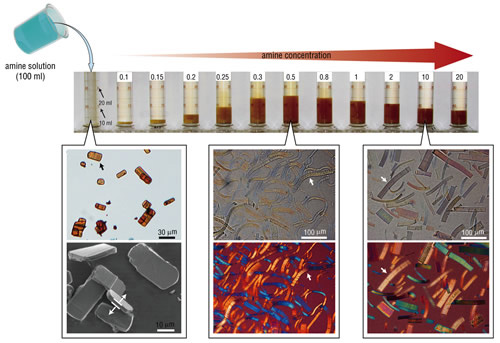The first observation of massive swelling and shrinkage of inorganic layered materials like a biological cell provides insights into the production of two-dimensional nanocrystals.
Two-dimensional (2D) nanocrystals have unique properties that may be useful for a range of applications. Consequently there is high interest in the mechanism for producing 2D nanocrystals by exfoliating materials with layered structures. Now researchers in Japan have reported an unusual phenomenon that layered materials undergo dramatic swelling without breaking into separate 2D crystal layers. “The findings demonstrate important implications for and chemical insight into the exfoliating process,” say the researchers.
Certain ions or solvents can infiltrate materials with layered structures. This ‘intercalation’ sometimes causes excessive swelling and ultimately exfoliation into separate layers. The process of exfoliation has been studied in a number of materials including graphite, metal oxides, and hydroxides among others. In all these materials, exfoliation into separate layers occurs after swelling of less than several nanometres, which raises difficulties in analysis of the swelling stage, and hence the exfoliation mechanism as a whole.
Now Takayoshi Sasaki and colleagues at the International Center for Materials Nanoarchitectonics at the National Institute for Materials Science and the Fukuoka Institute of Technology in Japan have realized up to 100-fold swelling of layered protonic oxides, otherwise known as solid acids, without exfoliation, by exposure to an aqueous amine solution. Adding HCl reduced them to their original size. Notably, in the process, more than 3000 molecular sheets, which make up the starting crystal, instantly move apart and return together in a manner similar to springing poker cards.
Unlike previously reported swelling or exfoliation, in which crystals swell far less before exfoliation, the swollen structures produced by exposure to the amine solution remained stable even when shaken. The researchers discuss the stability using molecular dynamics calculations. “Unlike the random H2O in the previously reported swollen phases that could be easily exfoliated, long-range structuring of the H2O molecules in the highly swollen structure was suggested using first-principle calculations.” The observations also provide important insights into the physics of these systems.

Macroscopic volume and microscopy characterization of the samples before and after swelling.
The parent H0.8[Ti1.2Fe0.8]O4・H2O microcrystals exhibit platelets with lateral sizes of ~15 µm×35 µm and a thickness of 2-3 µm. The interlayer spacing is 0.89 nm; thus, the platelets are composed of ~3000 regularly stacked layers. With addition of amine solutions, the samples “balloon” spontaneously, and the macroscopic volume of the swollen crystals changes with various DMAE solutions, which shows the maximum volume increase at DMAE/H+ = 0.5. Optical microscopy characterizations reveal extended lamellar structures. The longest swollen length is ~200-250 µm in DMAE/H+ = 0.5. At high concentrations, the swelling is somewhat suppressed, with swollen length of ~100 µm at DMAE/H+ = 10.
References
"Unusually stable ~100-fold reversible and instantaneous swelling of inorganic layered materials", Fengxia Geng, Renzhi Ma, Akira Nakamura, Kosho Akatsuka, Yasuo Ebina, Yusuke Yamauchi, Nobuyoshi Miyamoto, Yoshitaka Tateyama, Takayoshi Sasaki, 2013 Nature Comm, doi:10.1038/ncomms2641
ナノアーキテクトニクス材料研究センター(MANA)
〒305-0044 茨城県つくば市並木1-1
TEL: 029-860-4710
E-mail: mana-pr=ml.nims.go.jp([ = ] → [ @ ] )
To receive our e-mail newsletter “MANA Research Highlights”, please send an e-mail with "MANA Research Highlights request” in the subject line or main text to the following address: mana-pr_at_ml.nims.go.jp
*Please change "_at_ " in the email address to @.
 Research Highlights
Research Highlights


